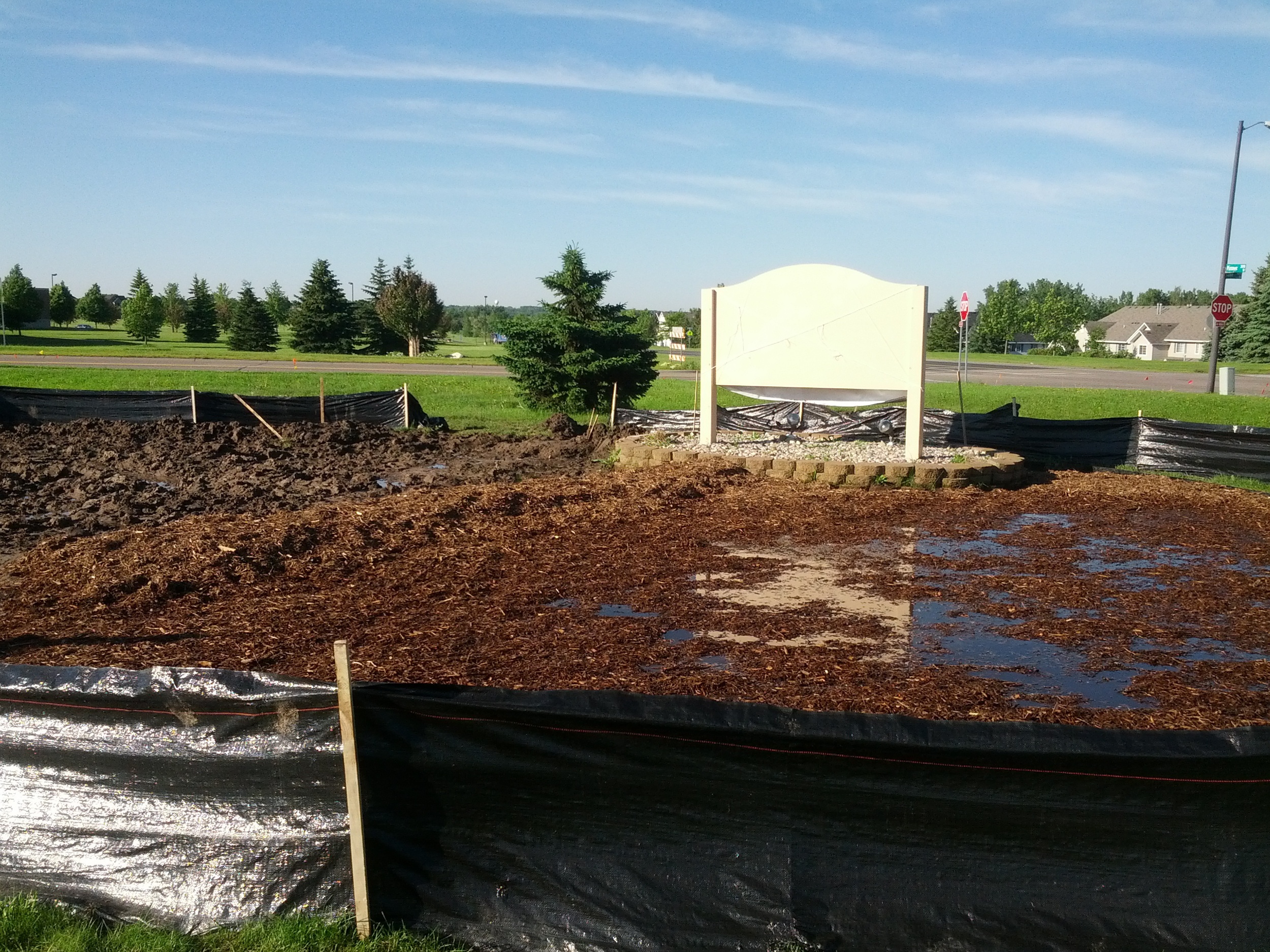Rain Garden Installation: Conservation Corps St. Paul Crew Edition

By: Nick Cox
Tuesday:
“We’ll use this walk-behind BobCat to dig up the sod and grade the basin of the garden, should be a piece of cake.”
That didn’t work.
“I bet we can get all this sod up pretty quickly with a couple of manual sod kickers.”
Turns out kicking up sod in saturated clay soil goes about as quickly as peeling a rotten orange with your feet.
Wednesday:
After two full work days a combination of BobCat, sod kickers, shovels, and brute arm strength proved to be the perfect an effective cocktail for removing the sod.
Thursday:
We get called off of the project, because what all of our hard work uncovered was a mud pit.We hope it dries out and for a machine capable grading the basin of the rain garden.
Monday:
“This backhoe is going to make for easy work today.”
Remember that orange we peeled with our feet? Now let’s break it apart into neat little pieces using only our forehead, nose and teeth.
“Well, let’s just work on the driest areas and move forward from there tomorrow.”
That brings us up to date.It took three full days of trial and error, ingenuity, and plain ol’ hard work to turn a soggy patch of sod into a mud pit that is just beginning to look like it could someday become a rain garden. On projects like this, it is simply amazing what a positive attitude and encouraging environment can provide. Sure, try that crazy but plausible idea. If I let you throw a mud ball at me, can I throw one at you?Bob is covered in mud and has to run to the airport for a flight directly from work.Bob forgot a change of clothes.
If I really try, of course I can remember how wet my feet were and how heavy that 10th wheelbarrow of wet sod was last week.But what comes to mind first are the shenanigans and the homemade lunches enjoyed with good company.As we continue with this project I look forward to seeing the rain garden come together as the fruit of our hard labor, but even more the endless fond memories this work consistently provides.
Rain Gardens 101:
If you’re reading this, chances are that you are in a building with a roof.There might be a driveway out front and definitely a road running by.If you’re in any sort of urbanized area, there are roofs, roads, and parking areas as far as the eye can see – this causes a problem for rainwater. These surfaces are all impermeable to water and we have stormwater and sewer systems that are developed to move rainwater from these surfaces and into nearby streams and rivers as quickly as possible. The problem lies in the fact that as this water moves from roof to street to sewer to storm pipes to stream, it picks up all kinds of nasty stuff. The kind of stuff that would make you think twice about eating a popsicle that fell onto the street, plus even worse microscopic stuff that causes all kinds of problems once it enters into aquatic ecosystems.Further, mad rushes of water in heavy rain events overload streams and rivers to the point of extreme erosion and flash flooding.
What can you do?Plant a rain garden of course!Rain gardens are a simple way to retrofit our impermeable neighborhoods to slowly allow rainfall to enter the groundwater, filtering out the stuff along the way.Their effectiveness lies in the plants that inhabit a rain garden.Native prairie species work well due to their deep roots that infiltrate the soil allowing water to drain as well as their ability to thrive in our climate. But most any plant will have a deeper root system than the sod grass that it will be replacing.Home rain gardens can be planted to catch roof water, to drain low spots where water typically stands after a rain, or to simply do your part to combat the issues mentioned above.Planting a home rain garden can be as simple as removing the sod from the low spot in your yard and planting flowers and grasses, or it can be as involved as hiring consultants and a design crew to make sure your rain garden will be as effective as possible.Rain garden maintenance is comparable to a vegetable garden the first year or two, but once the plants are established the garden more or less should take care of itself.A simple online search should turn up multiple results that can help you determine what kind of rain garden can work for you.

The rain garden is still full from Wednesday morning’s rain. Once the plants have established good root systems, the water should drain within 24-48 hours of the rain, it will take quite a bit longer without plants.